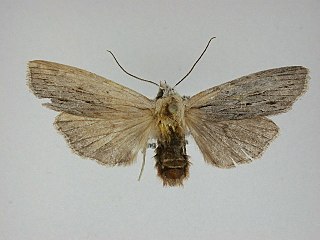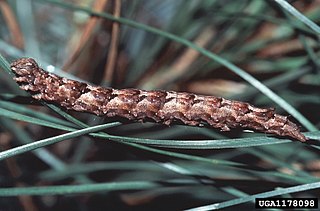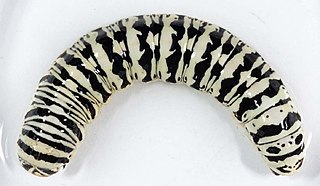
Acronicta lanceolaria is a moth of the family Noctuidae. It is found in North America, from Nova Scotia to British Columbia. It is listed as a species of special concern and believed extirpated in the US state of Connecticut.
Sideridis is a genus of moths of the family Noctuidae.

Lithophane lemmeri, Lemmer's noctuid moth or Lemmer's pinion, is a moth of the family Noctuidae. It is found in the eastern parts of the United States and adjacent areas in Canada. It is listed as a species of special concern in the US state of Connecticut. The species was first described by William Barnes and Foster Hendrickson Benjamin in 1929.

Argyrostrotis anilis, the short-lined chocolate, is a moth of the family Noctuidae. The species was first described by Dru Drury in 1773. It is found in North America from Quebec and Ontario, down through the eastern United States to Florida and Texas. It is listed as a species of special concern in the state of Connecticut.

Acronicta fragilis, the fragile dagger moth, is a moth of the family Noctuidae. It is found from Newfoundland to Florida, west across Canada, south to Kentucky and Minnesota. It is listed as a species of special concern in the US state of Connecticut.
Agrotis stigmosa is a moth of the family Noctuidae. It is found from New England west to Colorado, North Dakota, South Dakota and eastern Alberta. It is listed as a species of special concern in the US state of Connecticut.

Acronicta falcula is a moth of the family Noctuidae. It is found in the United States and Canada from southern New England to southern Manitoba and Iowa. Recently seen from Wisconsin, Connecticut, Rhode Island, New York and Michigan. It is reported as rare in Ohio. It is listed as a species of special concern in the US state of Connecticut.
The pink star moth is a species of moth of the family Noctuidae. It is found from southern Maine to Florida, west to Missouri and Texas.

Zale submediana, the gray spring zale, is a moth of the family Noctuidae. The species was first described by Strand in 1917. It is found in the US from Wisconsin to Maine, south to New Jersey and in mountains to North Carolina.
Drasteria occulta, the occult drasteria moth, is a moth of the family Erebidae. The species was first described by Henry Edwards in 1881. It is found in North America, where it has been recorded from coastal areas in Maine, New Jersey, Pennsylvania and Texas. It is listed as a species of special concern and believed extirpated in the US state of Connecticut.

Glena cognataria, the blueberry gray moth, is a moth native to North America. It ranges from Florida to Nova Scotia and New Brunswick. Its larvae is hosted on blueberry. The habitat consists of bogs and pine barrens. It is listed as a species of special concern and believed extirpated in the US state of Connecticut.

Cucullia speyeri, common names Speyer's paint, Speyer's cucullia or Speyer's hooded owlet moth, is a moth found in North America. It is found from Alberta and Montana to the Atlantic coast from New Hampshire to Virginia. It was described by Joseph Albert Lintner in 1874. In the US state of Connecticut, it is listed as a species of special concern and is believed to be extirpated. The habitat consists of open meadows, dry grasslands and native prairies.
Hydraecia immanis, the hop vine borer moth is a moth in the family Noctuidae native to North America. The species was described by Achille Guenée in 1852. It is listed as a species of special concern and is believed to be extirpated from the US state of Connecticut.
Apamea lintneri, the sand wainscot moth, is a species of moth native to North America. It is listed as a species of special concern in the US state of Connecticut. The species was described by Augustus Radcliffe Grote in 1873.
Euxoa violaris, the violet dart moth, is a species of moth native to North America. It is listed as a species of special concern in the US state of Connecticut. It was described by Augustus Radcliffe Grote and Coleman Townsend Robinson in 1868.
Fagitana littera, the marsh fern moth, is a moth of the family Noctuidae. It is listed as a species of special concern in the US state of Connecticut. It was described by Achille Guenée in 1852.
Lithophane viridipallens, the pale green pinion moth, is a moth of the family Noctuidae that is native to North America. It is listed as a species of special concern in the US state of Connecticut. It was described by Augustus Radcliffe Grote in 1877.
Sympistis perscripta, the scribbled sallow moth is a moth of the family Noctuidae that is native to North America. It is listed as a species of special concern in the US states of Connecticut and Massachusetts. It was described by Achille Guenée in 1852. The larval hosts are Antirrhinum, Linaria, and Nuttallanthus.
Photedes inops, common name Spartina borer moth, is a species of moth native to North America. The larvae are hosted on Spartina pectinata, apparently exclusively. It is listed as a species of special concern in the US state of Connecticut.
Metarranthis apiciaria, the barrens metarranthis moth, is a moth in the family Geometridae that is native to North America. The species was first described by Packard in 1876. It is listed as endangered in Massachusetts, and as a species of special concern in Connecticut.






